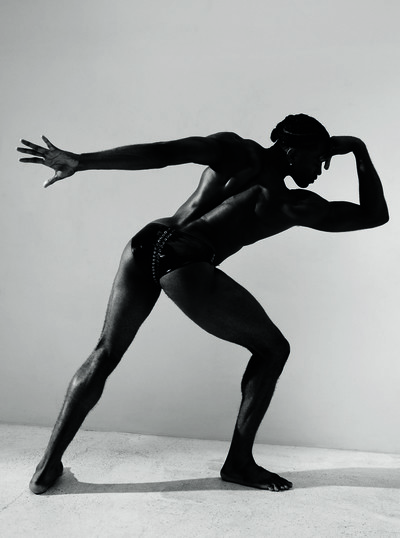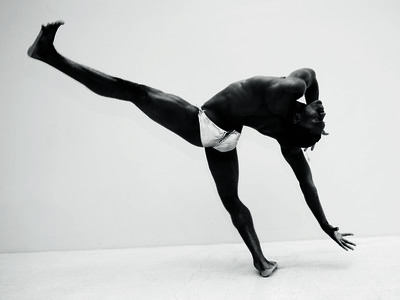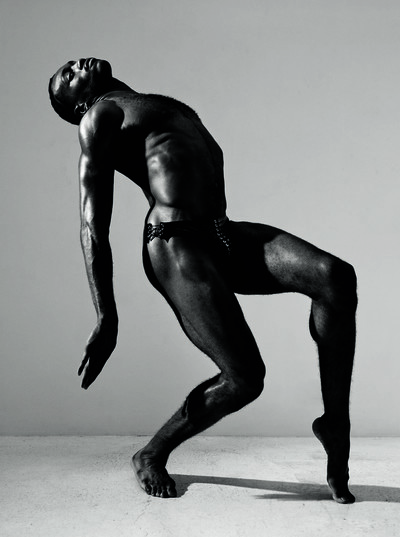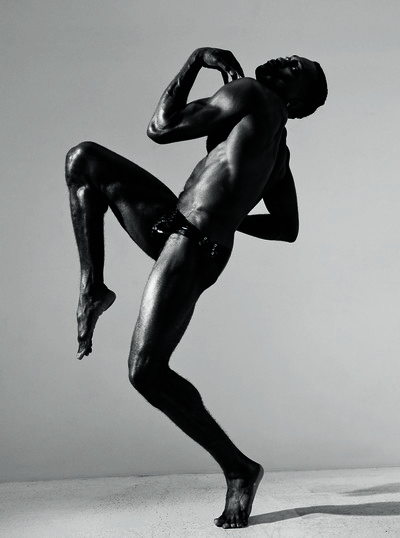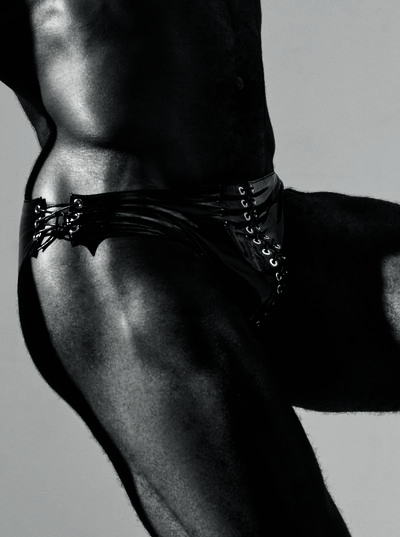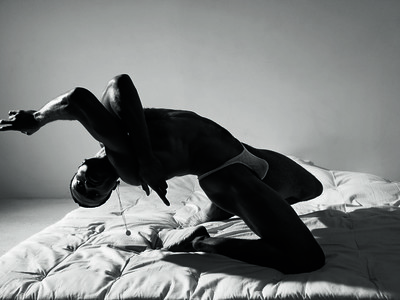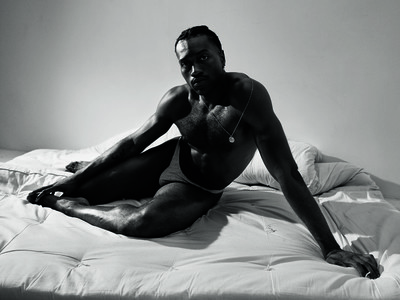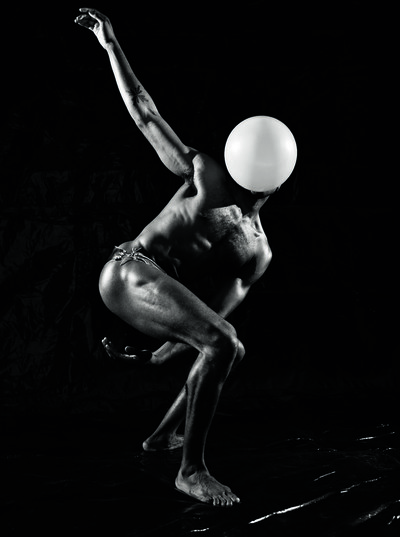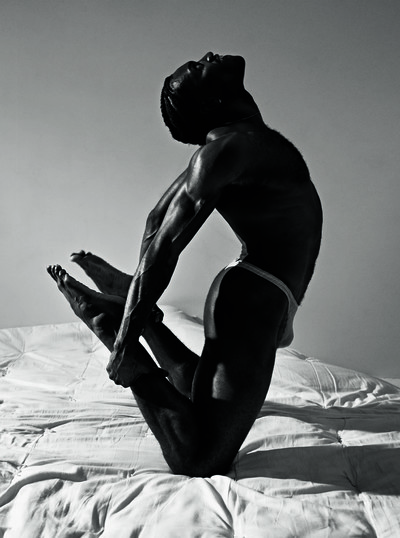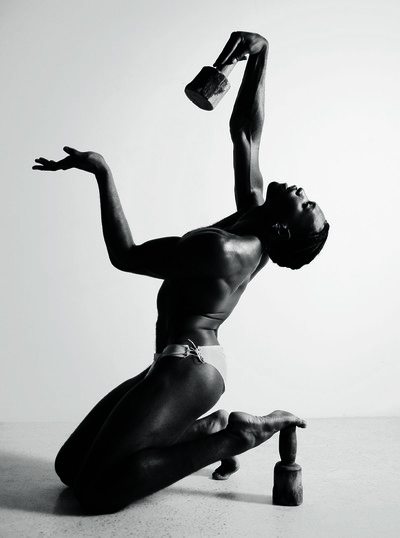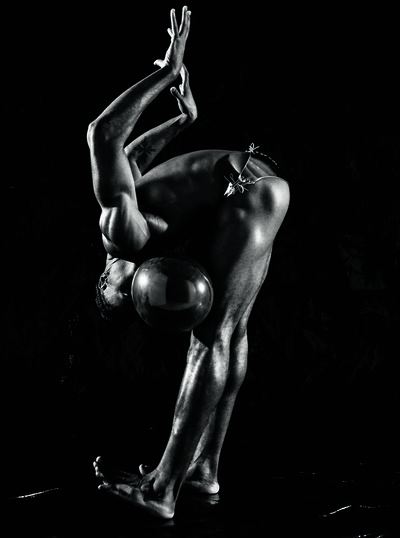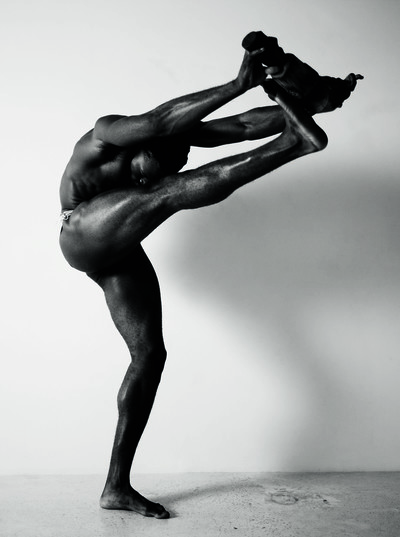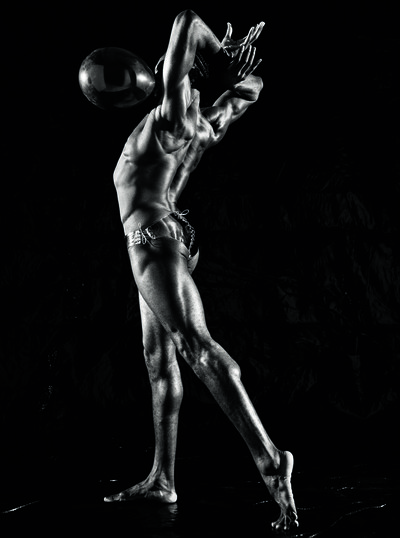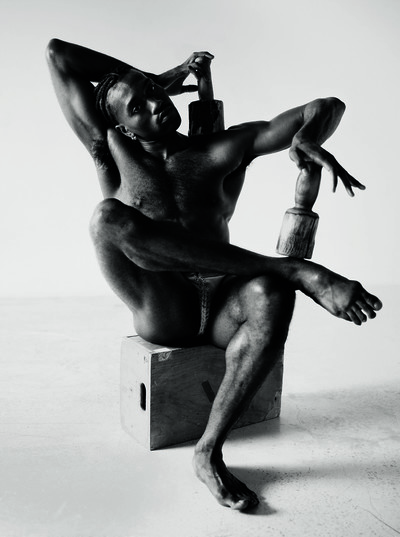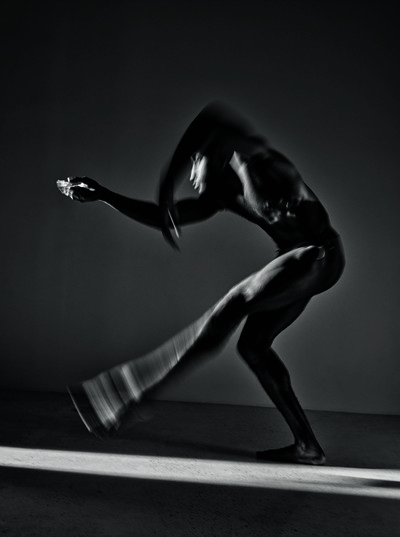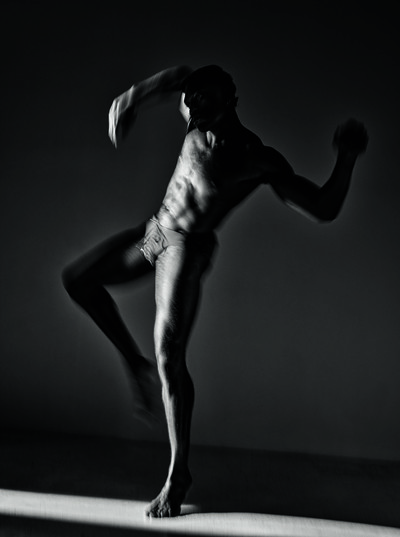When dancer Vinson Fraley, Jr. and photographer Mario Sorrenti collaborate, they ‘lean beyond choreography into abstraction.’
Photographs by Mario Sorrenti
Interview by Mahoro Seward
When dancer Vinson Fraley, Jr. and photographer Mario Sorrenti collaborate, they ‘lean beyond choreography into abstraction.’
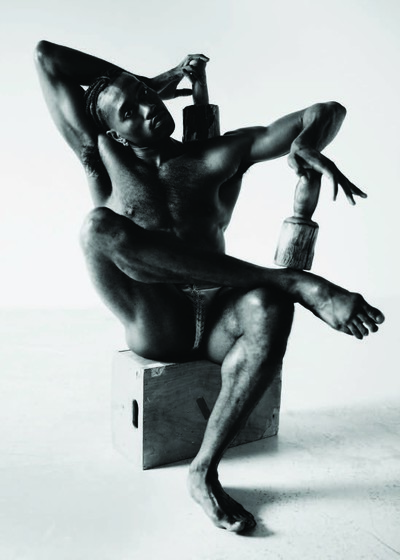
At a time when our own freedom of movement is so limited, there is something joyous in witnessing the lightness of captured motion. Photographers have long tried to find the magic required to freeze movement in a still image and often found the intersection of fashion and dance as a way to conjure their spells. The rapport between body and material, the flow of fabrics and form, have long inspired photographers and their muses: Richard Avedon and Veruschka, Jean-Paul Goude and Grace Jones, or more recently the bold poise of Luis Alberto Rodriguez’s images of ballroom voguer Kendall Miyake Mugler and ballet dancer Samuel F. Pereira. In each, the photograph’s success is based upon a creative conversation, a genuine collaboration in the purest sense: each image is a static token of an exchange of ecstatic energy.
Mario Sorrenti and Vinson Fraley, Jr.’s collaboration is another example, rooted this time in their shared desire to, as Vinson puts it, ‘lean into abstraction’ and ‘capture the essence’ of each freely choreographed gesture. Vinson, a 25-year-old Atlanta-born dancer who trained at New York University’s Tisch School of the Arts, is entirely of his time. He’s collaborated with experimental musician serpentwithfeet and contemporary artist Carrie Mae Weems, and has been part of dance legend Bill T. Jones’ company since 2017, but it’s on Instagram – @heyvinson – that the force and vigour of his creativity are perhaps best exhibited. It is where you can see him move to everything from Chloe × Halle to euphoric, thudding techno, all with a jaunty, balletic poise that creates contours as voluptuous as they are precise.
In the portfolio presented in these pages, this nuanced sexiness is accented by the garments Vinson wears: a thong and pair of leather eyelet briefs by Parisian menswear designer Ludovic de Saint Sernin. The briefs, described by the designer as the brand’s ‘iconic piece in the same way that the cone bra was for Jean Paul Gaultier’, are emblematic of the new space Saint Sernin has forged in contemporary menswear, bringing together sophisticated tailoring and a red-blooded masculinity. ‘I want to maintain an air of elegance and refined beauty,’ he says. ‘But at the same time, I also want to evoke a desire that’s unashamedly raw.’
Nine months after the photographs were taken in a different-looking world – before Covid and the emergence of Black Lives Matter into mainstream consciousness – Mario and Vinson sat down to reflect upon the fruits of their intense creative partnership, the sensuality of their and Ludovic de Saint Sernin’s work, and what it means today to collaborate as a Black subject and a white photographer.
How did you first meet and what triggered your interest in working together?
Mario Sorrenti: We first met shooting for i-D magazine about 18 months ago. I remember seeing Vinson warming up beforehand and I was, like, ‘Wow!’ I started photographing him, and I felt right away that there was something really incredible going on – a weird, unspoken understanding between us that was making the pictures happen.
Vinson Fraley, Jr: I love working with Mario because he leaves the space really open for me. I feel like I can lean into abstraction, like I can tap into his world and my world at the same time, which is how the magic happens; there is freedom, and, like he says, a kind of telepathy, an unspoken language. That comes from my admiration for Mario’s attention to detail and composition; these are things that I think about when I occupy the space he creates for me.
How did the collaboration come together this time?
Mario: Thomas [Lenthal at System] contacted me about shooting something with this sexy underwear from Ludovic de Saint Sernin. I looked it over and thought it was both really beautiful and strong at the same time. I immediately knew I didn’t want to be obvious and make an erotic image, which is what you’d expect with that underwear, but I knew it still had to be something associated with the body. That’s when I thought of Vinson, because what he brings is beautiful and sexy, but he’s not trying to be sexy. His work is more abstract than that; it starts with dance but extends into something more interesting. So I reached out to him, showed him the pieces, and he loved them.
What was the experience on set like? How do you go about creating the right mood for that performance to take place?
Mario: It was just Vinson and me in the studio; no stylist or hair and make-up. I brought along a few things from my house, like the stool and the wooden mallets – pieces my kids had made at school. When I take photographs I am very intuitive, so I brought just two or three pieces to the studio to see what Vinson would do with them, how he would transform them and make them his own.
‘You’re taking Nureyev or Nijinsky and bringing them into a contemporary language. It starts in the 1930s, and then, whoosh! Suddenly I’m in 2020.’
Do you work in silence and respond to one another or with music and specific direction?
Vinson: Both. For this shoot, Mario showed me about 10 references that we’d come back to, abstract things, almost, so I took information from them without being told exactly what to do. I just had a random shuffle playlist of sounds going, which I listened to but also pushed against or broke through; that brings tension to the images and the space. I also loved the props. They were like toys, yet I was wearing these sexy thongs, and somehow it still looks hot. I love it when you can bring things together that really contradict each other. With all the references, and the different lighting and the sounds playing, we had this beautiful sort of theatre inside the studio. We tried certain gestures that Mario thought would be interesting; he always knows how to respond quickly and give me the information I need to stay in the moment or move on from it.
Mario: I love the way Vinson moves and I kind of understand what he is trying to do, so I can quickly put myself in the right place to capture him in the most dynamic way. I get that he is trying to break the classical with something off-beat or a little quirky. I think we both try to achieve the same thing: to see what he is doing from the right perspective, from where it can be read properly. And then it is just playing, being honest, like when we played with the balloons: I just brought them along, with no idea what to do with them, and then he put one in his mouth and it obscured his face and it was just, like: ‘Wow, this is really abstract and playful.’ Those kinds of things aren’t planned, but as soon as they happen, we see them right away. It works for me when there is trust and intuition and willingness and an excitement about discovery. It is rare to have that relationship with someone, to create images like that.
Vinson: During a shoot, there is such a short amount of time to build that trust – just a few hours – but each time Mario and I are able to do it. When we created the pictures together for i-D, I felt like I could really see myself for the first time. There is something beautiful in how Mario manages to capture the essence, even when things are abstract.
Did you have any specific references in mind for the shoot?
Vinson: I am always referencing Bill T. Jones who I work for. There are beautiful images taken of him, most famously by Robert Mapplethorpe, Keith Haring, and Herb Ritts, and in the ones I love, his body is at the forefront of the image, and you can see him experiencing something in front of the camera. It takes a really wonderful photographer to be able to capture that spontaneity. In my mind, I thought of classic, romantic, faun-ish images, like ones of Nijinsky and Nureyev. But I also thought about images with brown bodies and the fantasies around them.
Mario: The thing I really enjoy about seeing you move and dance is that you’re taking Nureyev or Nijinsky and bringing them forward into a very contemporary language. When I watch you dance, it is like going through time: it starts in the 1930s, and then, whoosh! All of a sudden I am in 2020, because you change a gesture into something completely contemporary, but with this incredible thread that connects the two.
Vinson, could you explain your personal relationship with dance and movement and projecting your body when working with photographers? How has that evolved over the years?
Vinson: When I started about 10 or 11 years ago, the scope of how I looked at movement was so narrow, and now I see it in everything. I can understand the
composition of many things through movement; it’s been my way of creating a thread between mediums that may not otherwise make sense together, or of forms inside of my body that I want to mash together. I trained a lot and tried to fit into institutions and a certain classicism, but I found success fully fitting into those boxes was more exhausting than the actual dance itself. That made me question why I’d even want to be seen in front of the camera. I want to make room for nuance and subtlety and fantasy and for dreams, a dreamlike space. This shoot was really nice because some part of me wanted to allow my sensuality to show more than my sexuality. I have been photographed in a way where my sexuality was at the front of the image and it felt empowering, but maybe, in hindsight, those images aren’t actually digging anything up. Like, how much am I willing to let out and to display? What does it mean to perform and allow yourself to be a vessel of the moment with the photographer? I found it fun to play with that power and submission.
Mario: I think it is funny that you mention sexuality and sensuality. For me, the most important thing is not the sexiness, it is the sensuality that exists within the motion and the movement. This motion is sexy, sensual, but the most important thing is the expression of the movement and the dance.
‘I work in creative spaces where there is often a balance of power in the room, whether the person is Black, white, Asian, trans, or something else.’
The only clothing to feature in the shoot is Ludovic de Saint Sernin’s underwear, notably the leather eyelet briefs. How did these sensual garments fit into what you were trying to express and create?
Vinson: With many of the pieces, aesthetically, I was like, ‘Wow, these are striking – I wonder how I would look in these!’ I feel like I have never done something so forward, at least in terms of where it could have gone. The sexiness aspect was fun, too, certain pieces were maybe more masculine than other pieces, or more feminine, and it was fun to find that thread inside of my body. Like Mario said: it was about allowing expression to come through – ahead of my sexuality or my gender or my colour – simply in the shape and the cut and the colours and the hues and the textures of the garments.
Mario: We went beyond the sexuality of the pieces, trying to discover something new. It was liberating, because it gave us the opportunity to really focus on the body, on the figure, the expression, the motion. We let those things be the real power, the strength.
Vinson: In my dance and performance, I think the sex is going to show up by default. I find that I don’t really need to let it show, you know what I mean?
Mario: And the creative aspect of it is what I find sexy. Not sexy like throwing it in my face; the opposite of that. I find that really sexy.
Vinson, you’ve talked about Nureyev and Nijinsky and images of the brown body, and publishing your latest work with Mario at the end of 2020 invites questions about how race relates to this sort of collaboration. What are your perspectives on a Black subject and a white photographer working together in such an intimate way?
Vinson: I work in creative spaces where there is often a balance of power in the room, whether the person is Black, white, Asian, trans, or something else. Those spaces lend themselves to real communication, to a sort of stripping down, and you may come to a place where you find something beautiful that you would not have found without the tension in the room, without an agreement that needed to happen inside of that space. It is important to really listen to one another and understand what we each bring into the room, because in some instances a white photographer and a Black subject can be harmful, tokenizing or exploitative. The white photographer may not have any idea who the person is they are photographing, except that perhaps they were cast because a brand needed more brown
bodies to meet a diversity quota.
Mario: For me, personally, it’s really a very human thing: I was introduced to Vinson and I just fell in love with his talent, his emotion, his honesty, his expression, with what he was creating and the way he was creating it, and I love being a part of that.
Vinson: Thank you! From my perspective, Mario is really, really, gentle. People had told me that before I met him in person, but I was still nervous, even when we worked together this time, like, maybe the rapport won’t have the magic that it had the first time. But Mario gets what I am trying to get. And I look to him as someone I really want to learn from. When I look at his life, his experience, you know, I have nothing but gratitude.
